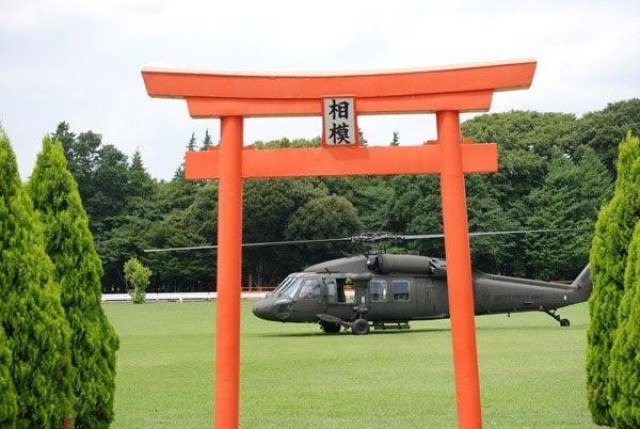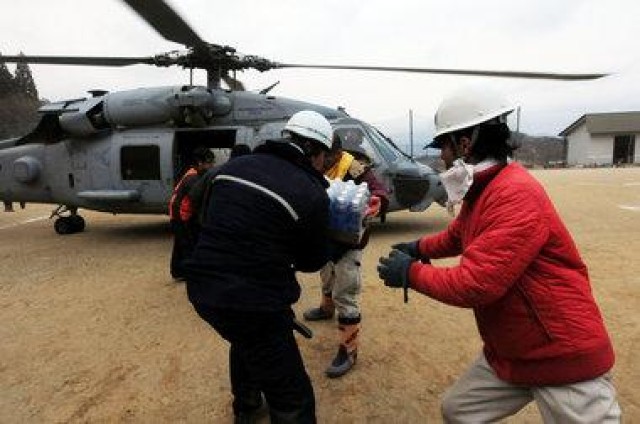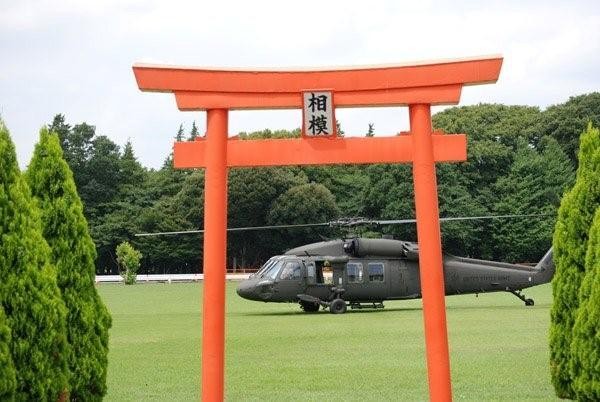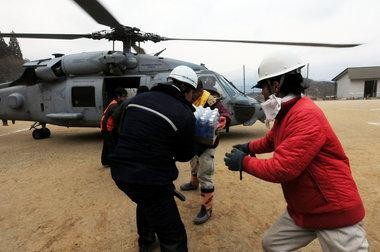REDSTONE ARSENAL, Ala.--Black Hawks have long been viewed as "freedom flyers" in countries where the Army uses utility helicopters for medical, search and rescue, transport and combat missions in support of troops on the ground.
But since the March 11 9.0-magnitude earthquake and subsequent tsunami in Japan, two of those "freedom flyers" have become symbolic with emergency assistance to this nation's people, who have been crushed by the two overwhelming natural disasters.
The mission success of the Black Hawks in Japan - flown by the Army's 78th Aviation Battalion based at Camp Zama - can be attributed to the helicopter's advanced technology, its well-trained pilots and crew, and the dedication of the U.S. to provide support to its allies.
That success can also be attributed to the behind-the-scenes work of 450-plus workers at Redstone Arsenal who daily ensure that Black Hawks are sustained and maintained throughout the world. Because of their work, the workers of the Utility Helicopters Project Office have a connection to the search-and-rescue missions flown by Black Hawks in Japan.
"We are very proud of our Soldiers and civilians who work around the globe in support of utility helicopters," said Gregory Gore, acting project manager for the Utility Helicopters Project Office, which is part of the Program Executive Office for Aviation.
"The 400 Black Hawks in the fight in two theaters right now (Iraq and Afghanistan) are our number one priority. But we support the war fighter in whatever mission they are in, including the 78th Aviation Battalion in Japan."
UH-60 Black Hawks are assigned to the 78th Aviation in Japan. Currently, two aircraft are assisting with search-and-rescue and disaster relief in that country. Other helicopters are deployed on mission to the Philippines. The two aircraft conducing Japanese emergency assistance are now operating from Sendai, the Japanese city closest to the earthquake's epicenter.
"How much flying these two Black Hawks are doing depends on the availability of the aircraft crew and the maintenance crew," Gore said. "What we do here is make sure they have the spare parts and the maintenance training to keep those Black Hawks flying for whatever mission they are assigned."
The 78th Aviation is part of U.S. Army, Japan, based at Camp Zama, and, as such is part of the Army's efforts in support of Operation Tomodachi, a U.S. joint armed forces assistance operation to support Japan in its recovery following the earthquake and tsunami. Black Hawks from the 78th flew a disaster assessment team to northeastern Japan on March 14 to assist in relief and humanitarian operations as well as set up a forward logistic base for supplies.
Under normal conditions, the mission of the 78th Aviation and its Black Hawk fleet is to conduct general support aviation operations in support of the U.S. Army's Japan/I Corps (Forward), and other U.S. services and agencies. The battalion deploys in support of regional contingencies, joint/bilateral exercises, and stability and support operations.
The Army's aviation units are designed to be self-sufficient, with their own crews trained to provide repair and maintenance for their aircraft. But when Black Hawks aren't flying, Gore is one of the first ones to know about it.
"Every morning we get operational reports of the 400 aircraft in theater," he said. "We know the number we have down and why they are down. If those aircraft are down because of a needed part, it is our primary mission to make sure that part is delivered.
"We are involved in the day-to-day care and fielding of all Black Hawk aircraft out there. The team in this office interfaces with units in the field every day to discuss maintenance requirements, spare parts, redistribution of aircraft, fielding of new models to replace older models and the movement of the aircraft around the force structure."
Since March 11, Gore and his team have been receiving status reports on the two Black Hawks operating in Japan at the controls of the 78th.
"We haven't received any reports back from the unit of any problems," he said.
"It's a testament to this office and the 450-plus people who come to work every day that Black Hawks are in a position to support and carry out missions. This earthquake is like any of the other humanitarian missions Black Hawks have been involved with in places like Deep Horizon in the Gulf (2010 oil spill) and the Haiti earthquake (in 2010), for example. They are there to do the mission."
The Army has additional Black Hawk units positioned along the Pacific Rim, including units at Kwajalein, Korea, Hawaii, the National Training Center, Fort Irwin, Calif., and in Yakima. The project office also supports the Navy's Sea Hawks indirectly with production contracts.
"There are a lot of Sea Hawks in Japan. We also support Navy Sea Hawks with spare parts as well as the Air Force and the Coast Guard. This is the most successful joint program in all the services," Gore said.
In the early hours of March 11, workers of the Utility Helicopters Project Office were in contact with the 78th as well as with units in Korea and Alaska to check on the status of Black Hawk helicopters. That contact continues.
"So far, no decision has been made to move aircraft into Japan," Gore said. "They are all strategically positioned to answer the call if that happens."
The Japanese Self-Defense Force does maintain its own fleet of 170-180 Black Hawks purchased directly from manufacturer Sikorsky Aircraft. The Utility Helicopters Project Office does provide technical assistance with those aircraft if needed.
There are 3,000 Black Hawk helicopters in operation worldwide by both the U.S. and 22 foreign allies. Besides the Japanese Self-Defense Force, other nations with their own fleets of Black Hawks include Argentina, Australia, Bahrain, Brunei, Colombia, Egypt, Greece, Hong Kong, Israel, Jordan, Korea, Malaysia, Mexico, Morocco, People's Republic of China, Saudi Arabia, the Turkish Jandarma, Spain, Philippines, Taiwan and Thailand.
"We still have an active production line for Black Hawk," said Wallace Newcomb, assistant product manager for readiness and sustainment, and fleet management in the Utility Helicopters Project Office. "The current production is for 2,135 Black Hawks."
The demand for this multi-platform medium-weight helicopter makes it difficult for the Army to fulfill all its mission needs for Black Hawks.
In future emergency situations, the Utility Helicopters Project Office expects to see the worldwide Black Hawk fleet assisted in emergency, rescue and medical situations by its up-and-coming sister helicopter - the light utility helicopter known as Lakota.
"The Lakota will free up 23 Black Hawks that will be reassigned to Guard units, and in support of the fight in Iraq and Afghanistan. Black Hawks are a combative aircraft and they are needed in theater. Lakota is for disaster relief, and if we can replace Black Hawks used for disaster relief with Lakotas, then we have more Black Hawks for theater," said Newcomb, who manages the worldwide Black Hawk fleet.
The smaller and easier to maneuver Lakota is quickly becoming a popular choice for homeland security and homeland defense. Currently, there are 150 of 345 Lakotas fielded, said Lt. Col. David Bristol, product manager for Light Utility Helicopters.
"The Lakota does not have a combat mission. It only flies in permissive environments," Bristol said.
Currently, the National Guard has been assigned 210 Lakotas with the other 135 assigned to active duty units in the U.S. and Germany. There are no current foreign military sales cases for the Lakota, but there is a lot of interest from U.S. allies, Bristol said.
But that doesn't mean the Lakota doesn't have an international presence.
"The Louisiana National Guard is getting ready to send two Lakotas to Haiti to help that country in its disaster relief," Bristol said.
"The Lakota has a multi-purpose platform based upon the Medevac platform in the commercial sector. It can provide all kinds of support, from medical emergency to VIP-variants for transportation."
Black Hawk and Lakota both have a worldwide mission that goes beyond the military.
"It's so much bigger than military deployments, being on the tip of the spear," said Jay Horne, operations chief for the Utility Helicopters Project Office. "Disaster relief is a worldwide operation we do, and that the Black Hawk and Lakota do very well. Utility helicopters have the largest fleet in all of PEO Aviation because of the missions they can do."
That mission success is firmly based on keeping in close touch with those who work on and fly Black Hawk and Lakota helicopters. Trips are made twice a year to theater by management in the Utility Helicopters Project Office to obtain information on the status of the helicopters and the concerns of Soldiers.
"We talk to everyone from the wrench turner to those who fly these helicopters. We want to hear the voice of the customer," Gore said. "We want to make this product better and better. The 450-plus employees who work on this program every day are proud of what these helicopters can do to support Soldiers and civilians."




Social Sharing